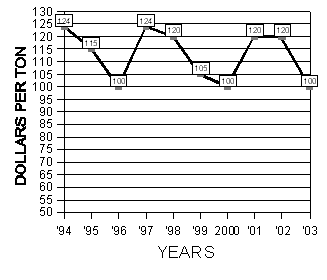Alfalfa Report
Yuma County, Arizona
March 24, 2003
Yuma County Office
2200 W. 28th Street, Ste. 102
Yuma, AZ 85364
(928) 726-3904
(928) 726-8472 FAX
Production Update:
Alternatives to alfalfa: Alfalfa is the most widely adaptable
and valuable forage legume grown in Arizona. Other legumes have been grown
in Arizona for forage, however, but with limited success. Cowpeas and
soybeans examples of warm season legumes were tried in Arizona at the
turn of the century. Cowpeas are drought tolerant and soybeans are susceptible
to salt and whiteflies. Cool season legumes include berseem clover, vetches,
winter pea, birdsfoot trefoil, annual medics, and various clovers. The
cool season legumes do not establish as quickly as cool season grasses
such as oats or barley, and may be behind in growth by a few weeks to
a month.
Insect Management: Egrets, Ibis, gulls, and redwing black birds are commonly seen in alfalfa fields. Birds are important predators of various insect pests in alfalfa including the very damaging granulate cutworm. Egrets, Ibis and gulls are often seen at the leading edge of irrigation water eating crickets and worms forced to move or drown. These birds feed during the day and roost at night. Therefore, they only eat the cutworms in lands where water is run during daylight hours. Black birds eat cutworms, other worm pests, and aphids on alfalfa stems.
Weed Control: Once day time temperatures reach 70oF, it is difficult to safely use the contact herbicides-Gramoxone and Buctril. These herbicides are more active when sunshine is bright and temperatures are warm. The best fit for these herbicides is during the winter when weeds are small and the crop has little foliage.
| Market Summary |
High
|
Low
|
Average
|
Off grade
|
| Past 2 Weeks (Mar 11 - Mar 24, 2003) |
102
|
95
|
100
|
85-95
|
| Last Year (Mar 11 - Mar 24, 2002) |
125
|
105
|
120
|
90-105
|
10 Year Summary (March 11, to March 24, 1994-2003):

Issued in furtherance of Cooperative Extension work, acts of May 8 and June 30, 1914, in cooperation with the U.S. Department of Agriculture, James A. Christenson, Director Cooperative Extension, College of Agriculture and Life Sciences, The University of Arizona.
The University of Arizona is an equal opportunity, affirmative action institution. The University does not discriminate on the basis of race, color, religion, sex, national origin, age, disability, veteran status, or sexual orientation in its programs and activities.
Any products, services, or organizations that are
mentioned, shown, or indirectly implied in this web document do not imply
endorsement by The University of Arizona.
Information provided by:
Barry Tickes, btickes@ag.arizona.edu Extension Agent, Yuma County
Michael Ottman, mottman@ag.arizona.edu Agronomy Specialist
College of Agriculture, The University of Arizona.
Eric Natwick, etnatwick@ucdavis.edu UCCE Imperial County - Farm Advisor
University of California, Davis, CA.
Forages: Crop Mgmt | Soil Mgmt | Irrigation | Alfalfa Reports | Insects | Diseases | Weeds | Pesticides
Home | Other Crops | Forages
For more Arizona Production Ag Information:
Home | Cotton | Veggies| Forages | Grains | Citrus | Crop x Crop | Insects | Diseases| Weeds | Pesticides | News | Weather | Research | Photos | Contacts | General Info. | Site Map
Copyright © 2001 University of Arizona,
College of Agriculture and Life Sciences
Webmaster: Al Fournier (fournier@ag.arizona.edu)